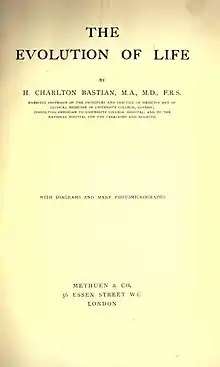Henry Charlton Bastian
Henry Charlton Bastian (26 April 1837 in Truro, Cornwall, England – 17 November 1915 in Chesham Bois, Buckinghamshire) was an English physiologist and neurologist.

Biography
Bastian was born at Truro, Cornwall and graduated from University of London in 1861.[1] He obtained his M.D. in 1866. He was elected a Fellow of the Royal Society in 1868 and a Fellow of the Royal College of Physicians in 1870.[1]
In 1867, Bastian was elected Professor of Pathology and Assistant Physician at UCL Medical School and successively became Professor of Clinical Medicine at UCL Medical School.[1] In 1868, he became assistant physician to the National Hospital for the Paralysed and Epileptic, then full physician in 1887. He served at the National Hospital until he retired in 1912.[1]
He was an advocate of the doctrine of archebiosis.[1] He believed he witnessed the spontaneous generation of living organisms out of non living matter under his microscope.
Works

- Monograph of the Anguillulidae (1865)
- The Modes of Origin of Lowest Organisms (1871)
- The Beginnings of Life: Being Some Account of the Nature, Modes of Origin and Transformation of Lower Organisms, I–II (1872)
- Evolution and the Origin of Life (1874)
- The Brain as an Organ of Mind (1880)
- The "muscular sense" its nature and cortical localisation (1887) [2]
- A Treatise on Aphasia and Other Speech Defects (1898)
- The Nature and Origin of Living Matter (1905)
- The Evolution of Life (1907)
- The Origin of Life (1911)
See also
References
- Pearce, J. M. S. (2010). Henry Charlton Bastian (1837–1915): Neglected Neurologist and Scientist. European Neurology 63: 73-78.
- Bastian, Henry Charlton (1887). "The "muscular sense" its nature and cortical localisation". Brain. 10 (1): 1–89. doi:10.1093/brain/10.1.1.
| Wikisource has original works written by or about: Henry Charlton Bastian |
Further reading
- Strick, James. (1999). Darwinism and the Origin of Life: The Role of H. C. Bastian in the British Spontaneous Generation Debates, 1868-1873. Journal of the History of Biology 32 (1): 51-92.